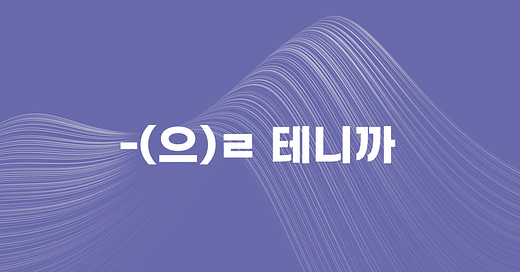Let's study about the Korean grammar expression "-(으)ㄹ 테니까" today. This expression is used to express a reason based on the speaker’s intention, assumption, or expectation about the future, often followed by a suggestion or instruction. It combines the assumption or intent "-ㄹ 테-" with "-니까" (meaning "because" or "since"), resulting in a structure that communicates both an assumption and a reason.
Definition:
"-(으)ㄹ 테니까" implies that, because something is likely to happen or the speaker intends for something to happen, a second action or suggestion should follow.
Usage:
Expressing the Speaker’s Intention: The speaker states their intention in the first clause and suggests a related action in the second clause.
Expressing an Assumption or Expectation: The speaker makes an assumption about something likely to happen, providing a basis for the second clause.
How to Form:
For verb/adjective stems ending in a vowel: Attach "-ㄹ 테니까"
Example: 하다 (to do) → 할 테니까For verb/adjective stems ending in a consonant: Attach "-을 테니까"
Example: 먹다 (to eat) → 먹을 테니까
Examples:
Speaker's Intention
제가 준비할 테니까 걱정하지 마세요.
(I’ll prepare it, so don’t worry.)제가 저녁을 만들 테니까 일찍 오세요.
(I’ll make dinner, so please come early.)
Expectation/Assumption About the Future
비가 올 테니까 우산을 챙기세요.
(It will probably rain, so bring an umbrella.)오늘은 피곤할 테니까 내일 봅시다.
(You’ll probably be tired today, so let’s meet tomorrow.)
Similar Grammar Structures:
"-(으)니까": Used to give a reason or basis for a following clause, but without the assumption or intent that “-(으)ㄹ 테니까” conveys.
날씨가 좋으니까 산책하러 갑시다. (Since the weather is nice, let’s go for a walk.)
"-(으)려고 하니까": Used to explain an upcoming plan or intention, often leading into a reason for an additional action.
저는 이제 집에 가려고 하니까 나중에 연락할게요. (I’m about to go home, so I’ll contact you later.)
Considerations:
"-(으)ㄹ 테니까" is often used in conversational contexts where the speaker wants to politely suggest something based on their plans or expectations.
This expression can also show consideration for the listener by setting up a reason that makes the following suggestion or instruction feel more appropriate.
What are the differences between "-(으)ㄹ 텐데" and "-(으)ㄹ 테니까"?
1. "-(으)ㄹ 텐데": Expressing Assumptions and Reactions
"-(으)ㄹ 텐데" is typically used to express the speaker’s assumption or expectation about a situation, often leading into a reaction, feeling, or related thought in the following clause. When "-텐데" is used, it’s common to see words that reflect the speaker’s worry, gratitude, or apology in the second part of the sentence, as it naturally conveys a response to an assumed situation. This form is often used when the speaker wants to softly suggest something or share a related feeling indirectly.
Examples:
비가 올 텐데 우산을 안 가져와서 걱정이에요.
(It will probably rain, so I’m worried because I didn’t bring an umbrella.)시험이 어려울 텐데 준비가 안 돼서 미안해요.
(The test will likely be hard, and I’m sorry I’m not prepared.)
Tentative Suggestions with "-(으)ㄹ 텐데": This expression can also be used to give indirect or tentative suggestions. In these cases, it can sound like the speaker is thinking out loud or politely suggesting something rather than directly advising.
Examples:
날씨가 추울 텐데 따뜻하게 입는 게 좋을 것 같아요.
(It will probably be cold, so it might be good to dress warmly.)사람이 많을 텐데 미리 예약하는 게 어때요?
(There will probably be a lot of people, so how about making a reservation?)
2. "-(으)ㄹ 테니까": Giving Direct Suggestions or Instructions
On the other hand, "-(으)ㄹ 테니까" is used when the speaker wants to give a reason for advice, instructions, or suggestions based on their intention or prediction. Unlike "-(으)ㄹ 텐데", this structure is not typically followed by expressions of worry, apology, or other emotions. Instead, "-(으)ㄹ 테니까" is followed by clear guidance or suggestions, making it a more direct and assertive form.
Examples:
내일은 바쁠 테니까 오늘 끝내자.
(I’ll be busy tomorrow, so let’s finish it today.)길이 막힐 테니까 일찍 출발하세요.
(The roads will likely be crowded, so leave early.)
Direct Suggestions with "-(으)ㄹ 테니까": When used to make suggestions, "-(으)ㄹ 테니까" serves as a strong reason for the listener to follow the speaker’s advice.
Examples:
날씨가 추울 테니까 따뜻하게 입으세요.
(It’ll be cold, so dress warmly.)사람이 많을 테니까 미리 예약하세요.
(There will be a lot of people, so make a reservation in advance.)
Summary:
"-(으)ㄹ 텐데" is commonly used to express assumptions with a following emotional reaction, soft suggestion, or tentative advice.
"-(으)ㄹ 테니까", however, presents the assumption as a reason to directly offer advice or guidance.
Mastering these differences will help you sound more natural and precise in Korean!
Would you like to try using "-(으)ㄹ 테니까" in some practice sentences?



